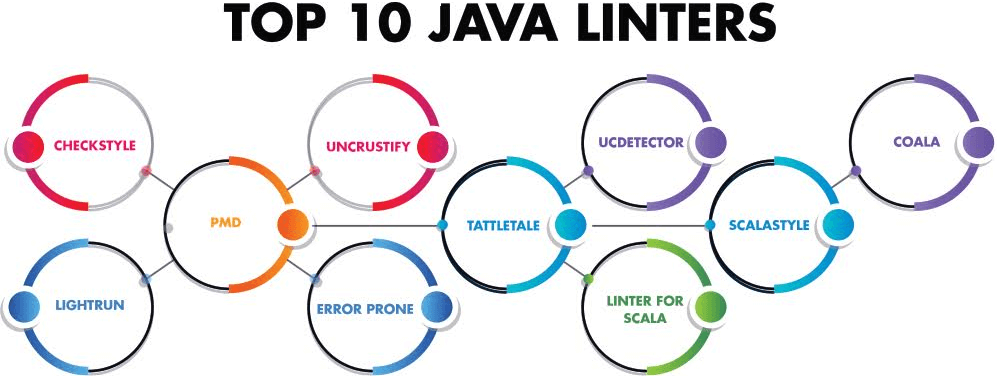Java LinterEveryone faces errors while dealing with programming. Errors are bad for the developers because hard to handle. Some errors cause glitches that puzzled users. For an application, the two most important concessions are safety and security. It does not matter what type of application we are developing. So, avoiding these errors is important for developers. It is the reason many developers rely on the linting process by using the linter. In this section, we will discuss what is linter and what are the top 10 Java linters. What is linting in programming?Linting is the process of automated checking of source code for programmatic and stylistic errors. It is done by using the lint (or linter) tool. Linting is an important part of development because it reduces errors and improves the overall quality of the code. Using the linting process we can accelerate the development and reduce the code of finding errors earlier. The linting process is done before code review and testing. What is Linter?The linter is basically a static code analyzer. It is an application or tool that helps developer to improve the code. It identifies errors when we use standard rules. Note that a linter analyzes our code for stylistic and programming errors against the rules it knows. If a part of our code breaks the standard rules, it can raise a problem. It is widely used in dynamically typed languages. 
When to Use lint Software?The use of linting software depends on which programming language we are using. Some programming languages are better suited for code linting than others. For example, Python and JavaScript lack compiling phase because these are interpreted languages. So, using a lint application or tool is effective for ensuring a reliable coding style and resolving basic coding errors in these cases. On the other hand, when it comes to compiled languages, like C and C++, the use of lint software is not enough. Compiled languages are more complex and may require more advanced code analysis. Top 10 Java Linters
Let's discuss each linter one by one. CheckstyleIt is a popular linter among developers. Regular update, community support thorough documentation makes it more popular. It works natively with Ant and CLI. Its plugin is also available for various IDEs, so it can be easily integrated with IDEs. It comes with pre-made configuration files that support both sun code conventions and Google Java style. LightrunIt is not actually a linter but it helps to improve code quality. It is a run-time debugger. It also prevents bugs before they raise a serious problem. Using Lightrun, we can insert logs, metrics, and snapshots in our code, even at runtime or directly from IDE or CLI. It also allows us to debug issues in production and run data analysis on our code without slowing down or interrupting the application. PMDIt is also a popular static code analyzer. It emphasizes on Java. It supports multi-language analysis, including salesforce, JavaScript, Apex, etc. It is very helpful if we want to use a single linter for the frontend and backend codebase. It finds common programming flaws like unused variables, empty catch blocks, unnecessary object creation, etc. Another feature is that it comes with a copy-paste-detector that finds the duplicate code block, so it is easier to find code that could be refactored. UncrustifyIt is a source code beautifier that supports various programming languages like Java, C, C++, Pawn, etc. It is highly configurable. It adds or removes spaces, new lines, and blank lines, indents and aligns code, and modifies code. Error-ProneIt is an error finder dedicated to Java. It is intended to supplement the compiler's static type checker. It finds potential runtime errors without executing the code. TattletaleIt is a tool that can help us to get an overview of the project on which we are working or a product that you depend on. The tools provide the following reports that can help developers:
UCDetectorUCDetector stands for Unnecessary Code Detector. It works is the same as its name implies. In addition to finding "dead" code, it also marks the classes whose privacy modifier could be changed from public to something more restricted and methods or fields which can be set to final. Linter for ScalaIt is Scala static analysis compiler plugin. It adds compile-time checks for various possible bugs, inefficiencies, and style problems. It is not only written for Scala but it is also written almost exclusively in Scala. ScalastyleIt is specially designed for Scale. It examines and indicates a potential problem with it. If we have come across Checkstyle for Java, then we will have a good idea of what Scalastyle is. Except that it's for Scala obviously. CoalaIt is the most flexible linter among all the above discussed. It claims that it works by, "linting and fixing code for all languages." The unique feature of Coala is that all the languages can be linted using a single configuration file. So, it is good to use Coala lint tool if we are working in a multi-language web environment. Therefore, it fulfills the developers need.
Next TopicJava Mod Example
|
 For Videos Join Our Youtube Channel: Join Now
For Videos Join Our Youtube Channel: Join Now
Feedback
- Send your Feedback to [email protected]
Help Others, Please Share










